Leaf Feeders
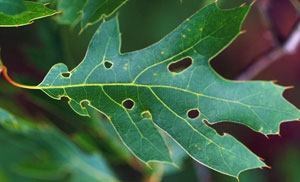
Steven Katovich, USDA Forest Service, Bugwood.org
Oak shothole leafminers
As adults, the females of these small flies will stab at new leaves and then drink the sap that is produced by this damage. As the leaf grows, these punctures will also expand. The maggots are small leafmining larvae and feed between the upper and lower layers of the leaf. This feeding creates a blotch mine that can be mistaken for anthracnose. Blotch mines are most obvious in May.
As adults, the females of these small flies will stab at new leaves and then drink the sap that is produced by this damage. As the leaf grows, these punctures will also expand. The maggots are small leafmining larvae and feed between the upper and lower layers of the leaf. This feeding creates a blotch mine that can be mistaken for anthracnose. Blotch mines are most obvious in May.
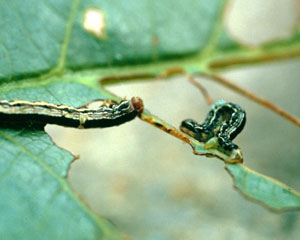
A. Steven Munson, USDA Forest Service, Bugwood.org
Fall cankerworm is a looper caterpillar that can vary from light green with yellow stripes to green with a dark stripe down the back. Overwintering masses of about 100 eggs hatch in later April or early May; small caterpillars chew small holes in young leaves at branch tips. Larger loopers leave only the midrib and major veins. Fall cankerworms are about an inch long when full grown. Mature larvae descend from trees on silk threads to pupate in the soil. They emerge as adults during periods of freezing temperatures to mate and lay eggs on host plants. There is one generation each year.
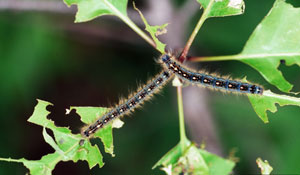
Steven Katovich, USDA Forest Service, Bugwood.org
Forest tent caterpillar is a brown caterpillar with a row of conspicuous keyhole-shaped whitish spots down the middle of the back; there is a blue and a yellow-brown line along each side. Eggs are laid in masses of 100 to 300 so there can be extensive feeding damage on heavily infested trees. Newly hatched larvae begin to feed at about the time of bud break. Groups of caterpillars tend to cluster in masses on lower trunks of infested trees. The first signs of infestation may be thinning crowns and a steady rain of pelleted caterpillar waste.
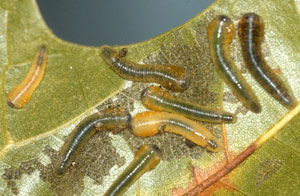
William A. Carothers, USDA Forest Service, Bugwood.org
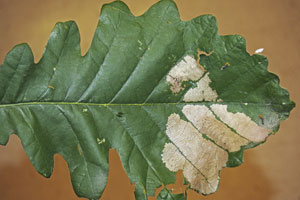
Jim Kalisch, University of Nebraska-Lincoln Dept. of Entomology
Oak slug sawfly, also known as the scarlet oak sawfly, feeds on scarlet, pin, black and white oaks. As larvae they are slug-like in appearance and even have a coating of slime to adhere to leaves. They feed on the underside of oak leaves, creating a transparent “windowpane” and skeletonization. Damage usually begins in the upper portion of the tree but progresses downward through the summer. Cocoons will overwinter below trees in litter or in soil and the new adults will emerge the following spring. The adults are small, stingless wasps. There are usually 2 generations per year, with adults emerging in July to produce the overwintering generation.
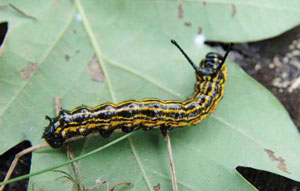
Brian Kunkel, University of Delaware, Bugwood.org
Orangestriped oakworm, a black caterpillar with 8 yellow longitudinal stripes, also has a pair of long curved horns just behind its head. Eggs hatch and larvae feed from July into September. Newly hatched larvae feed in groups, skeletonizing leaves by eating only the lower surface. They disperse as they grow but usually defoliate a branch before moving to another one. Full grown larvae are about 2 inches long. There is one generation each year.
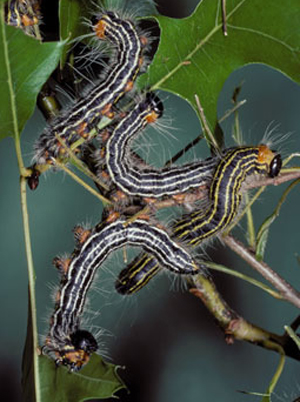
Gerald J. Lenhard, Louisiana State University, Bugwood.org
Feeding by Yellownecked caterpillars can cause striking cosmetic damage to some tree species but they do not threaten tree health. The distinctive caterpillars are red with yellow stripes when young, changing to black with yellow stripes near the end of their 4- to 6-week feeding period. Both stages have a red-orange plate just behind the head and on each leg.
Eggs are laid in clusters of 50 to 100 so damage tends to be limited to a specific area of at tree. Small larvae feed on the surface tissue of a leaf but later eat all of the leaf, leaving only the leaf petiole. There is one generation each year with most damage occurring in July and August.
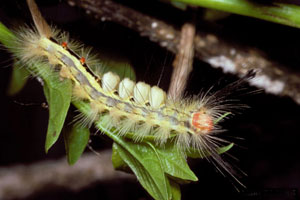
Gerald J. Lenhard, Louisiana State University, Bugwood.org
The whitemarked tussock moth caterpillar feeds primarily on oak but will attack other hardwoods. About 1.5 inches long when full-grown, its most distinctive features are pair of black hair tufts just behind the head and 4 clumps of brush-like hairs down its back. Young larvae chew small round holes in leaves, older larvae feed inward from the edge of the leave, leaving only large veins and midribs. There are 2 generations each year.

Jon Yuschock, Bugwood.org
A Gypsy moth egg mass will contain between 500 and 1,000 eggs and has a tan, fuzzy appearance. Egg masses can be found all winter long however, they will not hatch until spring. Larvae emerge from egg masses from early spring until mid-May. Hatching usually coincides with the budding of most hardwood trees. Fully grown caterpillars will be approximately 2 inches long, very hairy and have five pairs of blue dots followed by six pairs of red dots along the back. Gypsy moth caterpillars might be confused with fall webworms or eastern tent caterpillars. However, both of these insects form webs; the gypsy moth does not. For more information, see Entfact 425.
Sap Feeders
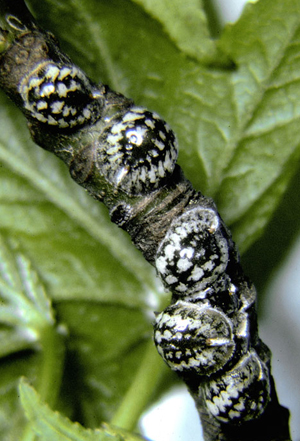
Raymond Gill, California Department of Food and Agriculture, Bugwood.org
Calico scale is a white and dark brown soft scale about 1/4 inch in diameter. It produces a large amount of honeydew in the spring so twigs, branches, and leaves may be covered with sooty mold. This scale can severely weaken trees, making them more vulnerable to drought and other stresses. Egg hatch occurs in May and the crawlers move to leaves to feed for the summer. Nymphs move back to bark for the winter.
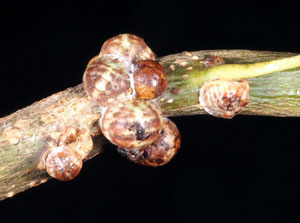
Jim Kalisch, University of Nebraska-Lincoln Dept of Entomology
Pin oak kermes scale and Bur oak kermes scale are the most common species found on oak trees. These are soft scales, which resemble an inverted leathery bowl. They can cause dieback, stunted growth, and produce honeydew which in turn causes sooty mold issues. On bur oak, the scales overwinter as nymphs and feed on new leaves around April (causing future distortion). After mating, new crawlers appear in June. Pin oak kermes crawlers are present in September and they cause significant damage at the junction of new and old growth, leading to terminal growth falling out of trees the following July.
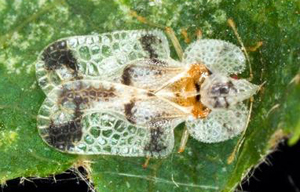
David Cappaert, Bugwood.org
Lace bugs are flat gray sap-feeding insects with clear, ornate, lacy wings; nymphs are spiny and wingless. Both stages live on the lower surface of leaves. As they feed, they leave tiny yellow to white spots on leaves and dark, varnish-like waste spots on the under sides. These lace bugs spend the winter as eggs under bark or in leaf litter. The eggs hatch in early spring and the nymphs begin to feed on plant sap. There are several generations each season. Initially, numbers are so small that feeding symptoms are not noticed until the population peaks in late summer. When abundant, feeding can make plants unsightly and may cause premature leaf drop.
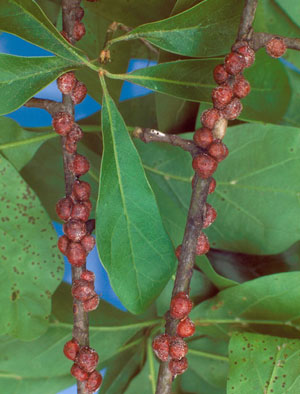
James Solomon, USDA Forest Service, Bugwood.org
Lecanium scale, a 0.25 inch diameter tortoise-shaped scale located on twigs, can reduce growth and cause crown die-back. Eggs under the scale hatch in early summer and the crawlers move to the undersides of leaves. They return to the bark in late summer and move to twigs to spend the winter.
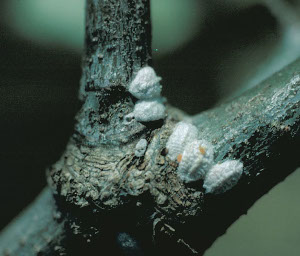
Larry R. Barber, USDA Forest Service, Bugwood.org
Oak felt scales (also known as Oak eriococcin scales) feed on sap from the new growth of oak trees. Felt scales superficially resemble mealy bugs; they are white, cotton-like fluffs on bark, twigs, and branches. They produce similar symptoms to soft scales, including production of honeydew. Female felt scale produce eggs in the spring and North Carolina State University research has shown they are some of the earliest scale crawlers to emerge. They have only one generation a year.
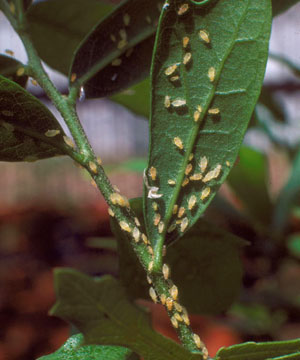
James Solomon, USDA Forest Service, Bugwood.org
Oak leaf aphids are very small yellow to brown aphids that live in clusters on the undersides of leaves. Heavy infestations can result in distorted leaves and accumulations of sooty mold and honeydew. These aphids spend the winter as eggs in bark crevices. They are most abundant in early spring.
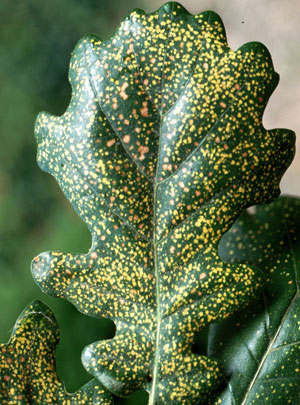
Andrea Battisti, Universita di Padova, Bugwood.org
Oak phylloxera are small, spiny aphid-like insects that live on buds and developing leaves. Foliage on infested terminals may be distorted.
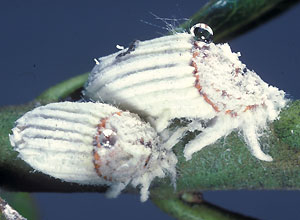
Sturgis McKeever, Georgia Southern University, Bugwood.org
Cottony cushion scale is an invasive scale species that can be found feeding on the sap of numerous species of plants. Adult females are orange-brown but coated with white wax and will have a long, fluted egg sac attached to the body. This can contain up to 1,000 eggs. After hatching, the nymphs (which are red with dark antennae and legs) will seek a suitable space for feeding. Nymphal feeding on leaves can cause extensive damage and honeydew/black sooty mold will accumulate as the population builds.
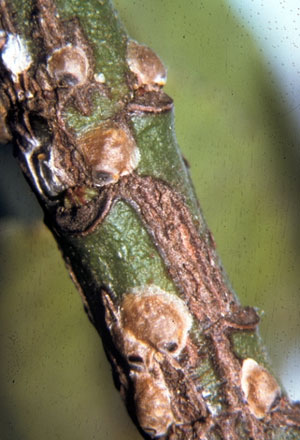
United States National Collection of Scale Insects Photographs,
USDA Agricultural Research Service, Bugwood.org
Greedy scale are small armored scales that create a conical shaped cover. As they grow and shed their old exoskeleton, it is incorporated into the wax that makes up the shield. Eventually this results in a characteristic off-center nipple or dot on the outer coating. There are often concurrent overlapping generations on plants
Borers
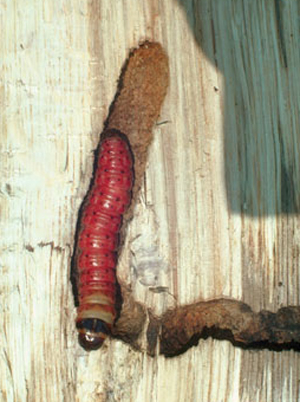
James Solomon, USDA Forest Service, Bugwood.org
Carpenterworms are reddish pink caterpillars that tunnel into the bark and wood of oaks, especially red oaks and a number of other hardwoods. Their damage causes unsightly scars on ornamental trees and degrades rough sawn lumber. Eggs are laid in bark crevices or under vines and lichens. Small larvae feed into the phloem and cambium but soon chew into the sapwood. Fine frass mixed with sap is ejected from the entrance hole in the bark and builds up at the base of the tree as larvae hollow out galleries beneath the bark. Infested trees usually are not killed but long term attacks may weaken trees structurally.
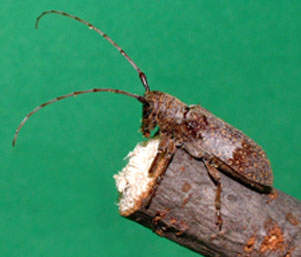
Jim Kalisch, University of Nebraska-Lincoln Dept of Entomology
Twig girdler adults usually emerge from August into October. Female beetles mate and then cut a groove around small twigs. The female then lays an egg in the section beyond the cut where the larva will feed on dead wood. The twig will often turn brown and flag before dropping to the ground. The larva overwinters as an early instar and then resumes feeding the next spring.
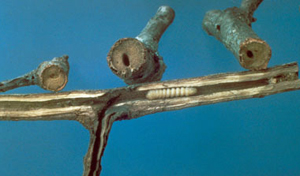
James Solomon, USDA Forest Service, Bugwood.org
Twig pruners are the larvae of small beetles that tunnel in twigs and small branches. Female beetles lay their eggs about the time of bud break in the spring. Eggs are laid in small holes which are chewed into the bark. The larvae that hatch from these eggs bore into and tunnel toward the base of twigs. In late summer, they chew concentric circles outward toward the bark then move toward the tip. The twig eventually snaps and falls to the ground. The larva pupates in the fallen twig and emerges as an adult in the spring. Collecting and destroying fallen twigs can help to reduce infestations.
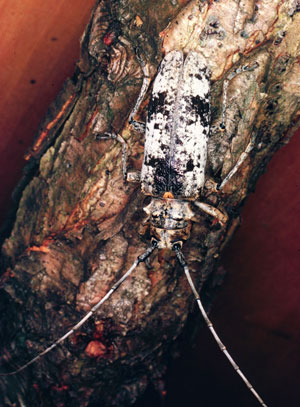
James B. Hanson, USDA Forest Service, Bugwood.org
The larvae of White oak borer feed on living tissue of white oak trees. They prefer smaller trees but can be found in established plants as well. White oak borer has a three-year development period and emerge as adults starting in May of the third year. They usually mate and lay eggs from May- June but adults can be seen from May-October. Adults are longhorn beetles with noticeably long antennae and white scales on much of the body.

James Solomon, USDA Forest Service, Bugwood.org
Twolined chestnut borer selects red and white oaks that have been weakened by stresses such as drought or defoliation. The white legless larvae destroy the cambium and girdle the tree.
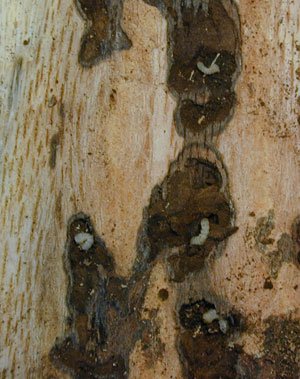
University of Arkansas Forest Entomology Lab, University of Arkansas, Bugwood.org
The Red oak borer is more common in red, black, and scarlet oaks but can be found in most other oak species as well. The larvae are round-headed borers that feed under the bark for 2 years. Their activity can cause wet spots on bark and they also push our wood slivers and piles of frass from trees. Adults tend to emerge in odd-numbered years and are present from June-August.
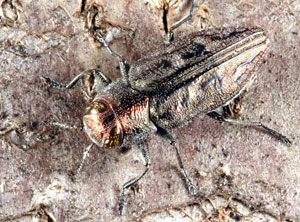
Jim Kalisch, University of Nebraska-Lincoln Dept of Entomology
The Flatheaded apple tree borer is particularly a problem for small, newly planted trees. Larvae are active all summer and feed in the cambium. The feeding damage progresses from the bottom, up the tree, girdling it. Trunks are often deformed and sucker growth may also be seen. As adults they are copper-colored jewel beetles that emerge in May.
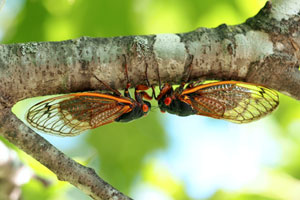
Jim Kalisch, University of Nebraska-Lincoln Dept. of Entomology
Periodical cicadas emerge every 13 or 17 years, depending on the species. Unlike annual cicadas, which commonly emerge in July and August, periodical cicadas emerge in spring. As adults they are black, with orange highlights on their wings, and red eyes. The females use a sharp, sword-like ovipositor to cut into twigs and lay eggs. This causes flagging in the canopy and can be a problem for newly transplanted trees.
Galls
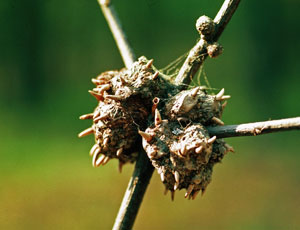
USDA Forest Service - Northeastern Area , USDA Forest Service, Bugwood.org
Gouty and horned oak galls are irregular woody growths on twigs and small branches that are produced by tiny black wasps. Generations in the life cycle of the insect alternate between a blister-like leaf gall form and the woody growth. There is no effective control.
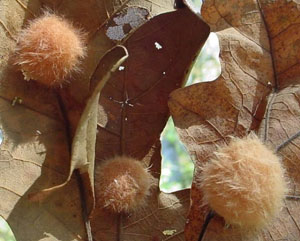
Herbert A. 'Joe' Pase III, Texas A&M Forest Service, Bugwood.org
Fuzzy oak gall can be found on white and chestnut oaks. The galls and leaves fall to the ground in autumn and adult wasps emerge in the spring. Oviposition occurs in April.
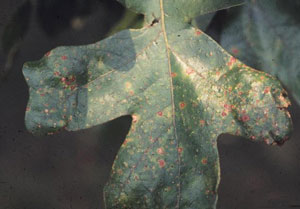
Jim Baker, North Carolina State University, Bugwood.org
Caused by a small wasp, Jumping oak galls typically appear on the leaves of valley oak and California white oak. These round, seed-like galls fall off leaves when mature. One wasp lives inside each gall; the wasp's activity may make the gall "jump" several inches off the ground. Female wasps emerge in the spring from galls on the ground and lay eggs in opening buds. After several weeks, small blister-like galls form on the young leaves. During the summer, males and females mate and females lay eggs in the mature leaves.
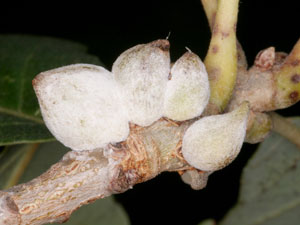
Jim Kalisch, University of Nebraska-Lincoln Dept of Entomology
Oak bullet gall are often found on bur and swamp white oaks where they can cause girdling and twig loss as well as attract numerous stinging insects. The galls start small and green, become larger and red by midsummer, and finally brown knuckle-sized "bullets" by summer's end. Inside of each gall is an individual larva feeding. In the fall, adults emerge, and females lay their eggs in present buds. As the larvae develop, they excrete honeydew which attracts insects like ants and wasps.
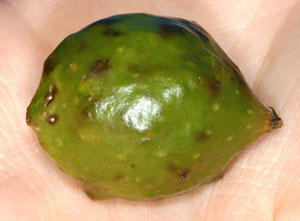
Jim Kalisch, University of Nebraska-Lincoln Dept of Entomology
Oak apple galls are large, apple-like swellings on leaves that are caused by a small stingless wasp. The gall is a home to a small wasp larva that lives in the center. The apple is green when the wasp larva is active inside, but once the adult emerges it will turn crispy and brown.